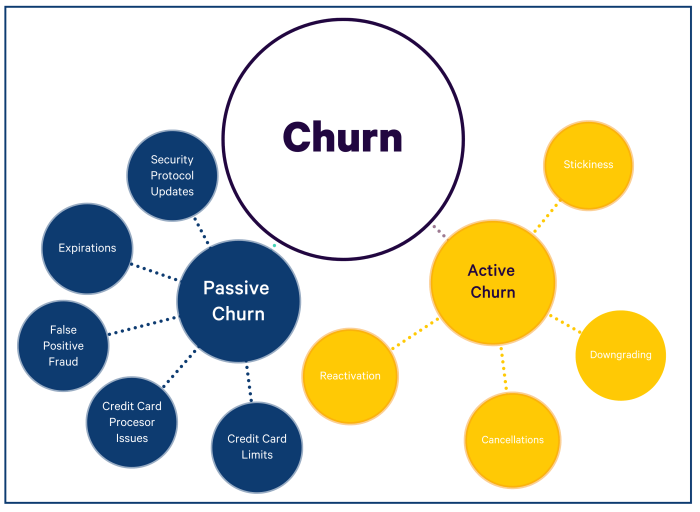Understanding Customer Churn sets the stage for exploring how businesses are affected by customer turnover, offering insights into the strategies and methods used to predict, manage, and minimize this phenomenon.
Let’s uncover the layers of customer churn and discover its implications in the business world.
Understanding Customer Churn
Customer churn is a term used to describe the percentage of customers who stop using a company’s products or services during a certain time period. It is a crucial metric for businesses as it directly impacts revenue and profitability.
There are several factors that contribute to customer churn, including poor customer service, high prices, lack of product quality, and increased competition. Customer churn can also be influenced by changes in customer needs and preferences, as well as ineffective marketing strategies.
Examples of Industries Affected by High Customer Churn Rates, Understanding Customer Churn
- In the telecommunications industry, customers often switch providers due to better deals offered by competitors, leading to high churn rates.
- In the software industry, customers may stop using a particular software product due to bugs, lack of updates, or difficulty in use, resulting in increased churn.
- In the subscription-based business model, companies may experience high churn rates if customers do not perceive the value of the subscription or find it too expensive.
Predicting Customer Churn: Understanding Customer Churn
When it comes to predicting customer churn, businesses rely on various methods and models to anticipate when customers are likely to leave. By accurately predicting churn, companies can take proactive measures to retain customers and minimize revenue loss.
Machine Learning Models for Churn Prediction
One popular method used for predicting customer churn is through the application of machine learning models. These models analyze historical data to identify patterns and factors that indicate a customer is at risk of churning. Some common machine learning algorithms used for churn prediction include:
- Logistic Regression: This model is often used to predict binary outcomes, making it suitable for determining whether a customer is likely to churn or not.
- Random Forest: Random Forest algorithms are effective in handling large datasets and capturing complex relationships between variables, making them valuable for churn prediction.
- Gradient Boosting Machines: These models are known for their ability to improve prediction accuracy by combining multiple weak learners, enhancing the overall churn prediction performance.
Importance of Accurate Churn Prediction
Accurate churn prediction is crucial for businesses to maintain customer loyalty and sustain revenue growth. By identifying customers who are likely to churn, companies can implement targeted retention strategies, such as personalized offers, improved customer service, or product enhancements, to mitigate churn risk and increase customer retention rates. Additionally, accurate churn prediction enables businesses to allocate resources more efficiently, focusing efforts on high-risk customers and maximizing the impact of retention initiatives.
Impact of Customer Churn

When it comes to customer churn, the financial implications can be significant for businesses. High customer churn rates can directly impact revenue and profitability, as acquiring new customers is often more costly than retaining existing ones. This can lead to a decrease in overall revenue and hinder business growth.Customer churn not only affects the financial aspect but also has a profound impact on customer loyalty and brand reputation.
When customers churn, it indicates a loss of trust and satisfaction in the brand. This can tarnish the brand’s reputation and make it challenging to attract new customers in the future. Additionally, loyal customers are more likely to recommend the brand to others, so losing them can result in a negative word-of-mouth effect.To mitigate the negative impact of customer churn, businesses can implement strategies to improve customer retention.
Providing excellent customer service, personalized experiences, loyalty programs, and proactive communication can help enhance customer satisfaction and loyalty. Analyzing customer feedback and behavior can also help identify potential churn risks and allow businesses to address issues before customers decide to leave. By focusing on building strong relationships with customers and continuously improving the overall customer experience, businesses can reduce churn rates and foster long-term customer loyalty.
Retention Strategies

Effective customer retention strategies are crucial for reducing churn and maintaining a loyal customer base. These strategies involve proactive efforts to keep customers satisfied and engaged with the brand, ultimately increasing long-term profitability. One key aspect of successful retention programs is focusing on building strong relationships with customers and providing exceptional customer service.
Personalized Communication
One effective retention strategy is personalized communication with customers. This involves understanding customer preferences and behavior to tailor communication and offers specifically to their needs. By sending personalized emails, messages, or offers, companies can make customers feel valued and appreciated, increasing their loyalty to the brand.
Reward Programs
Implementing reward programs is another successful retention strategy. By offering rewards, discounts, or special promotions to loyal customers, companies can incentivize repeat purchases and increase customer retention. These programs not only encourage customer loyalty but also create a sense of exclusivity and belonging among customers.
Exceptional Customer Service
Customer service plays a crucial role in reducing customer churn. Companies that prioritize exceptional customer service by resolving issues promptly, providing helpful assistance, and listening to customer feedback are more likely to retain customers. By delivering outstanding customer service experiences, companies can build trust and loyalty, ultimately reducing churn rates.
